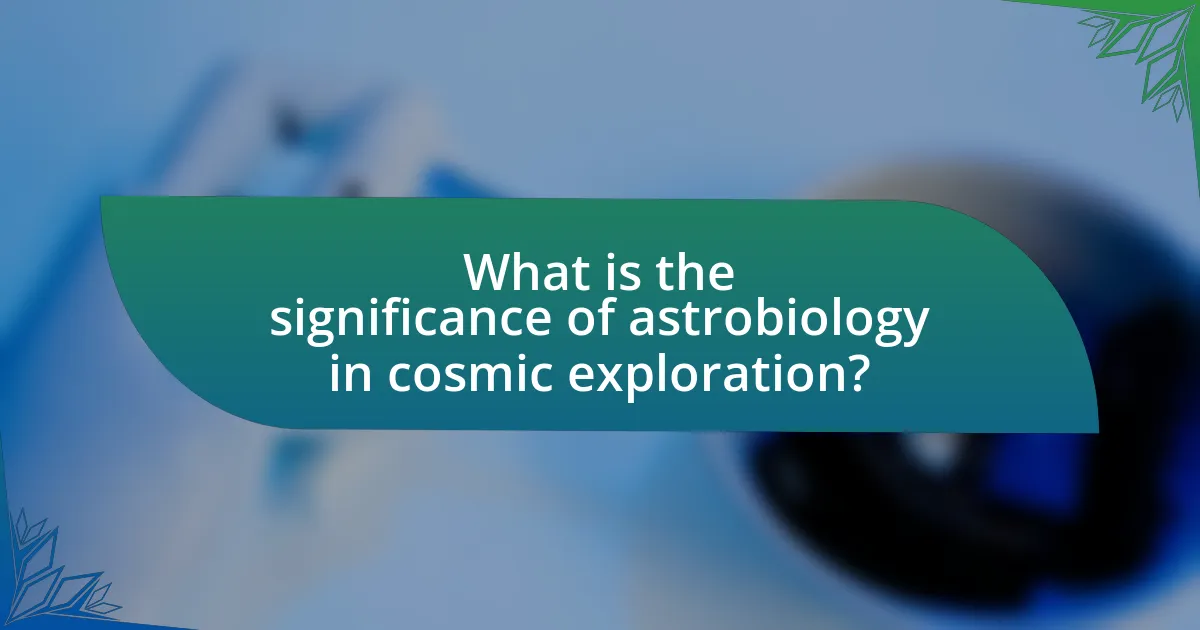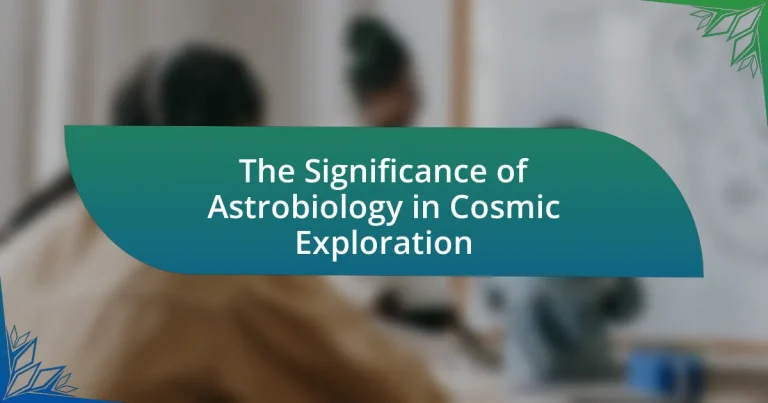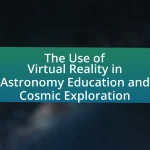Astrobiology is a crucial field in cosmic exploration, focusing on the potential for life beyond Earth by integrating biology, chemistry, and planetary science. This article outlines the significance of astrobiology in guiding space missions, understanding habitable environments, and detecting biosignatures. It discusses the principles of astrobiology, its interdisciplinary nature, and its role in future space missions, while also addressing the challenges and limitations faced in research. Furthermore, the article highlights how astrobiology informs our understanding of Earth’s biosphere and the origins of life, as well as the technological advancements and upcoming missions that will enhance astrobiological exploration.

What is the significance of astrobiology in cosmic exploration?
Astrobiology is significant in cosmic exploration because it seeks to understand the potential for life beyond Earth, guiding missions to other planets and moons. This field combines biology, chemistry, and planetary science to identify habitable environments and biosignatures, which are indicators of life. For instance, the discovery of extremophiles on Earth has expanded the understanding of where life might exist, influencing missions to Mars and the icy moons of Jupiter and Saturn. Additionally, astrobiology informs the search for exoplanets in the habitable zone, enhancing the scientific rationale for space exploration initiatives.
How does astrobiology contribute to our understanding of life beyond Earth?
Astrobiology enhances our understanding of life beyond Earth by investigating the potential for life in diverse environments, both within our solar system and on exoplanets. This scientific field combines biology, chemistry, and planetary science to explore the conditions necessary for life, such as water, energy sources, and chemical building blocks. For instance, the discovery of extremophiles—organisms that thrive in extreme conditions on Earth—has expanded the range of environments considered habitable, suggesting that life could exist in places previously thought inhospitable, like the subsurface oceans of Europa or the atmosphere of Venus. Additionally, missions like the Mars rovers have provided evidence of past water activity, reinforcing the possibility of ancient microbial life on Mars. Thus, astrobiology not only informs our search for extraterrestrial life but also shapes our understanding of life’s resilience and adaptability in the universe.
What are the key principles of astrobiology?
The key principles of astrobiology include the study of the origin, evolution, distribution, and future of life in the universe. These principles focus on understanding how life can arise under various environmental conditions, the potential for life on other planets, and the biochemical processes that sustain life. For instance, astrobiologists examine extremophiles—organisms that thrive in extreme conditions on Earth—to infer the possibilities of life on planets like Mars or moons such as Europa. This approach is supported by findings from missions like the Mars rovers, which have detected organic molecules and signs of past water, indicating that life may have existed there.
How does astrobiology intersect with other scientific disciplines?
Astrobiology intersects with other scientific disciplines by integrating concepts from biology, chemistry, geology, and astronomy to explore the potential for life beyond Earth. This interdisciplinary approach allows astrobiologists to study the conditions necessary for life, such as the chemical building blocks found in extreme environments on Earth, which can inform the search for extraterrestrial life. For instance, the collaboration between astrobiology and geology helps in understanding planetary environments, while chemistry provides insights into the molecular processes that could support life. Additionally, astronomy contributes knowledge about exoplanets and their atmospheres, enhancing the search for habitable worlds. This convergence of disciplines is essential for developing comprehensive models of life’s origins and evolution in the universe.
Why is astrobiology essential for future space missions?
Astrobiology is essential for future space missions because it provides critical insights into the potential for life beyond Earth and informs the search for habitable environments. Understanding the conditions that support life, as demonstrated by research from NASA’s Astrobiology Institute, helps mission planners identify suitable targets for exploration, such as Mars and the icy moons of Jupiter and Saturn. This field combines knowledge from biology, chemistry, and planetary science, enabling scientists to develop instruments and methodologies for detecting biosignatures, which are indicators of past or present life. By integrating astrobiological principles, future missions can maximize their chances of discovering extraterrestrial life and understanding the origins of life in the universe.
What role does astrobiology play in the search for extraterrestrial life?
Astrobiology plays a crucial role in the search for extraterrestrial life by studying the potential for life in environments beyond Earth. This interdisciplinary field combines biology, chemistry, and planetary science to understand the conditions that could support life elsewhere in the universe. For instance, astrobiologists investigate extreme environments on Earth, such as hydrothermal vents and acidic lakes, to identify life forms that thrive under harsh conditions, which may resemble those found on other planets or moons. Research conducted by NASA’s Astrobiology Institute has highlighted the importance of understanding microbial life in extreme environments, suggesting that similar life forms could exist on Mars or the icy moons of Jupiter and Saturn. This evidence supports the hypothesis that life could arise in diverse environments, guiding missions to explore these celestial bodies for signs of life.
How can astrobiology inform the design of life-support systems for space travel?
Astrobiology can inform the design of life-support systems for space travel by providing insights into the conditions necessary for sustaining life in extreme environments. Research in astrobiology identifies the biochemical pathways and environmental factors that support life on Earth and potentially elsewhere, such as the presence of water, energy sources, and nutrient cycles. For instance, studies of extremophiles—organisms that thrive in harsh conditions—reveal how life can adapt to limited resources, which can guide the development of closed-loop life-support systems that recycle air, water, and nutrients efficiently. This knowledge is crucial for long-duration missions, such as those to Mars, where resupply from Earth is not feasible.

What are the methods used in astrobiology research?
Astrobiology research employs various methods including observational astronomy, laboratory experiments, and field studies. Observational astronomy utilizes telescopes and space missions to detect exoplanets and analyze their atmospheres for potential biosignatures. Laboratory experiments simulate extraterrestrial environments to study the survival and behavior of extremophiles, organisms that thrive in extreme conditions, providing insights into possible life forms on other planets. Field studies involve exploring extreme environments on Earth, such as hydrothermal vents and polar ice caps, to understand the limits of life and inform the search for life beyond Earth. These methods collectively enhance our understanding of life’s potential in the universe.
How do scientists detect signs of life on other planets?
Scientists detect signs of life on other planets primarily through the analysis of atmospheric gases, surface conditions, and potential biosignatures. They utilize telescopes and space missions to observe exoplanets, focusing on the presence of gases like oxygen, methane, and carbon dioxide, which can indicate biological processes. For instance, the detection of oxygen alongside methane in an atmosphere could suggest active biological processes, as these gases typically react with each other and would not coexist in significant amounts without a replenishing source. Additionally, missions like the Mars rovers analyze soil and rock samples for organic compounds and microbial life, providing direct evidence of past or present life. The study of extremophiles on Earth also informs scientists about the potential for life in harsh environments elsewhere in the universe.
What technologies are employed in astrobiological studies?
Astrobiological studies employ a range of technologies including spectroscopy, robotic spacecraft, and bioinformatics. Spectroscopy is used to analyze the chemical composition of celestial bodies, allowing scientists to detect organic molecules and assess potential habitability. Robotic spacecraft, such as Mars rovers, are equipped with instruments to conduct in-situ analysis of planetary surfaces and atmospheres. Bioinformatics tools facilitate the analysis of biological data, helping researchers understand the potential for life in extreme environments. These technologies collectively enhance our understanding of life’s potential beyond Earth, as evidenced by missions like the Mars Science Laboratory, which has provided critical data on Martian geology and climate.
How do laboratory experiments simulate extraterrestrial environments?
Laboratory experiments simulate extraterrestrial environments by recreating specific conditions found in space, such as temperature extremes, pressure variations, and radiation levels. Researchers utilize vacuum chambers to mimic the low-pressure conditions of outer space, while temperature-controlled environments replicate the extreme cold or heat of celestial bodies. Additionally, scientists often use specialized equipment to expose samples to high levels of radiation, similar to what is encountered on planets like Mars or moons like Europa. These controlled settings allow for the study of biological responses and chemical processes under extraterrestrial-like conditions, providing insights into the potential for life beyond Earth.
What are the challenges faced in astrobiology research?
Astrobiology research faces several significant challenges, including the difficulty of obtaining direct evidence of extraterrestrial life, the vastness of space which complicates exploration, and the limitations of current technology in detecting biosignatures. The search for life beyond Earth is hindered by the inability to conduct in-situ studies on distant planets and moons, as exemplified by the challenges faced in missions to Mars and Europa. Furthermore, the extreme conditions of potential habitats, such as high radiation levels and extreme temperatures, pose additional obstacles for both robotic and human exploration. These factors collectively complicate the validation of astrobiological hypotheses and the interpretation of data collected from space missions.
What limitations exist in current astrobiological methods?
Current astrobiological methods face several limitations, including the inability to directly sample extraterrestrial environments and the reliance on indirect detection techniques. These methods often depend on remote sensing and modeling, which can lead to uncertainties in interpreting data about potential biosignatures. For instance, the search for life on Mars is hampered by the challenges of accessing subsurface environments where life may exist, as highlighted by the Mars 2020 mission’s focus on sample collection rather than direct analysis. Additionally, current technologies may not adequately differentiate between biological and abiotic processes, complicating the identification of life. These limitations underscore the need for advancements in both technology and methodology to enhance the effectiveness of astrobiological research.
How do scientists address the uncertainties in astrobiological findings?
Scientists address uncertainties in astrobiological findings by employing rigorous methodologies, including peer review, replication of results, and interdisciplinary collaboration. These approaches enhance the reliability of findings by ensuring that multiple experts evaluate and validate the data. For instance, the use of advanced statistical models helps quantify uncertainties in measurements related to extraterrestrial environments, such as the detection of biosignatures on Mars. Additionally, scientists often utilize a precautionary principle, acknowledging the limitations of current knowledge and remaining open to alternative explanations. This is evident in the ongoing debates surrounding the interpretation of potential microbial life in extreme environments on Earth, which serve as analogs for extraterrestrial conditions.
How does astrobiology influence our understanding of Earth’s biosphere?
Astrobiology enhances our understanding of Earth’s biosphere by providing insights into the conditions necessary for life and the potential for life beyond Earth. This field studies extreme environments on Earth, such as hydrothermal vents and acidic lakes, revealing how life can thrive under harsh conditions, which informs our understanding of potential extraterrestrial habitats. Research, such as that conducted by the NASA Astrobiology Institute, demonstrates that microbial life can exist in environments previously thought uninhabitable, suggesting that similar life forms could exist on other planets or moons. This comparative analysis of life on Earth and potential life elsewhere deepens our comprehension of biological resilience and adaptability, ultimately enriching our knowledge of Earth’s own biosphere.
What insights does astrobiology provide about the origins of life on Earth?
Astrobiology provides insights into the origins of life on Earth by exploring the conditions and processes that may have led to the emergence of life. Research indicates that life likely began in extreme environments, such as hydrothermal vents or shallow pools, where essential chemical reactions could occur. For instance, studies of extremophiles—organisms that thrive in harsh conditions—suggest that similar processes could have been present on early Earth, facilitating the formation of complex organic molecules. Additionally, the discovery of amino acids and other organic compounds in meteorites supports the idea that the building blocks of life could be synthesized in space and delivered to Earth, further informing our understanding of life’s origins.
How can studying extreme environments on Earth inform astrobiological theories?
Studying extreme environments on Earth can inform astrobiological theories by providing insights into the potential for life in similar conditions on other planets. For instance, organisms known as extremophiles thrive in harsh environments such as deep-sea hydrothermal vents and acidic hot springs, demonstrating that life can exist under extreme temperature, pressure, and chemical conditions. Research conducted by the NASA Astrobiology Institute has shown that these organisms possess unique adaptations that allow them to survive, which can be analogous to potential life forms on celestial bodies like Mars or Europa, where similar extreme conditions may prevail. This understanding helps refine the search for extraterrestrial life by identifying the types of environments that could support life beyond Earth.
What parallels exist between Earth’s life forms and potential extraterrestrial organisms?
Parallels between Earth’s life forms and potential extraterrestrial organisms include the fundamental biochemical processes, such as DNA-based genetics and cellular structures. Both Earth organisms and hypothetical extraterrestrial life may utilize similar molecular building blocks, like amino acids and nucleotides, which are essential for life as we understand it. For instance, the discovery of amino acids in meteorites, such as the Murchison meteorite, suggests that the building blocks of life could be widespread in the universe, supporting the idea that life elsewhere might share biochemical similarities with life on Earth. Additionally, extremophiles on Earth, which thrive in harsh environments, provide a model for potential extraterrestrial organisms that could exist in extreme conditions, such as those found on Mars or the icy moons of Jupiter and Saturn. These parallels highlight the potential for common evolutionary pathways and biochemical frameworks across different planetary environments.
What future directions are anticipated in astrobiology?
Future directions in astrobiology include the exploration of exoplanets, advancements in astrobiological instrumentation, and the study of extremophiles to understand life’s potential in diverse environments. The search for biosignatures on exoplanets, particularly those in the habitable zone, is a key focus, as missions like the James Webb Space Telescope aim to analyze their atmospheres for signs of life. Additionally, the development of new technologies, such as improved spectrometers and robotic exploration tools, will enhance our ability to detect and analyze potential life forms on other celestial bodies. Research on extremophiles, organisms that thrive in extreme conditions on Earth, provides insights into the types of environments where life might exist elsewhere, supporting the hypothesis that life could survive on planets with harsh conditions, such as Mars or the icy moons of Jupiter and Saturn.
How might advancements in technology enhance astrobiological research?
Advancements in technology significantly enhance astrobiological research by enabling more precise detection and analysis of extraterrestrial environments. For instance, the development of advanced telescopes, such as the James Webb Space Telescope, allows scientists to observe distant exoplanets and analyze their atmospheres for biosignatures. Additionally, robotic missions equipped with sophisticated instruments, like the Mars Perseverance Rover, facilitate in-situ analysis of soil and rock samples, providing insights into the potential for life on other planets. These technological innovations improve data collection and analysis, leading to a deeper understanding of the conditions necessary for life beyond Earth.
What upcoming missions are focused on astrobiological exploration?
Upcoming missions focused on astrobiological exploration include NASA’s Artemis program, which aims to return humans to the Moon and establish a sustainable presence, facilitating research on lunar resources that may support life. Additionally, the European Space Agency’s Jupiter Icy Moons Explorer (JUICE) mission, set to launch in 2023, will investigate the habitability of Jupiter’s moons, particularly Europa, Ganymede, and Callisto, which are believed to harbor subsurface oceans. These missions are significant as they aim to enhance our understanding of potential life beyond Earth, supported by advancements in technology and international collaboration in space exploration.
What practical steps can individuals take to engage with astrobiology?
Individuals can engage with astrobiology by pursuing education in relevant scientific fields such as biology, chemistry, and astronomy. This foundational knowledge is crucial, as it equips individuals with the necessary skills to understand complex astrobiological concepts. Participating in online courses or workshops offered by institutions like NASA or universities can enhance understanding and provide practical insights into current research.
Additionally, individuals can join local or online science clubs and organizations focused on astrobiology, which often host lectures, discussions, and collaborative projects. Engaging with scientific literature, including journals like Astrobiology, allows individuals to stay updated on the latest discoveries and theories in the field.
Volunteering for citizen science projects, such as those that analyze data from space missions or contribute to research on extremophiles, provides hands-on experience and contributes to ongoing scientific efforts. Lastly, attending conferences or public lectures on astrobiology fosters networking opportunities with professionals and enthusiasts, further deepening engagement in the field.




